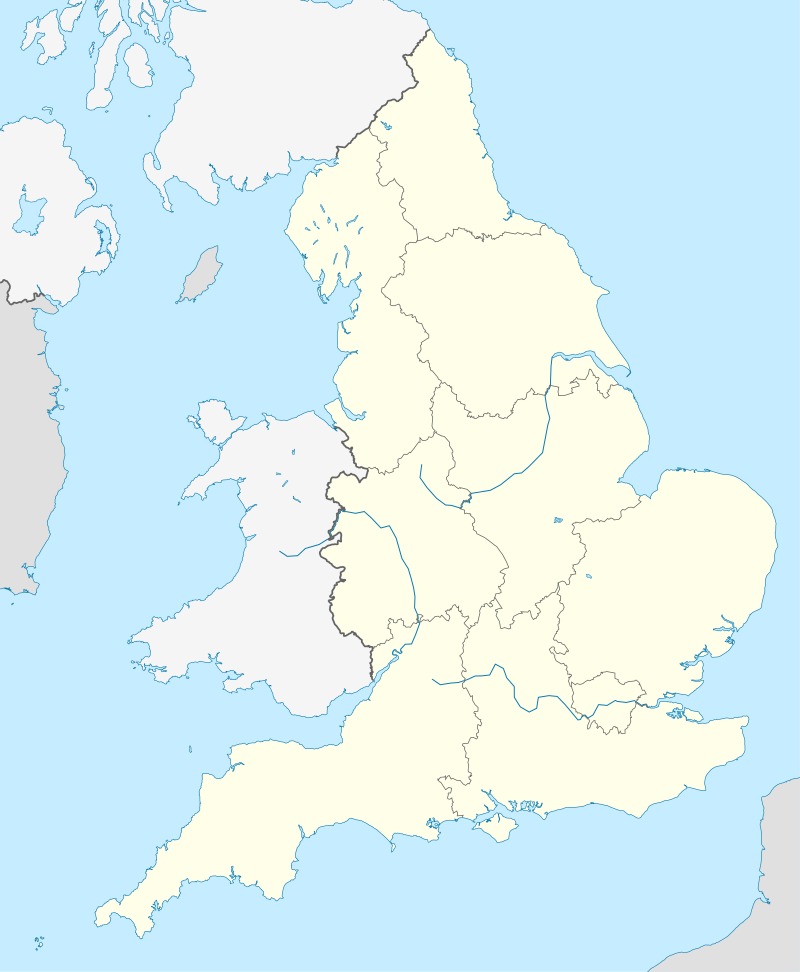British Rail Class 25
The British Rail Class 25 diesel locomotives, also known as Sulzer Type 2 were a class of 327 locomotives built between 1961 and 1967 for British Rail. They were numbered in two series, D5151-D5299 and D7500-D7677.[1]
| British Rail Class 25 | |||||||||||||||||||||||||||||||||||||||||||
|---|---|---|---|---|---|---|---|---|---|---|---|---|---|---|---|---|---|---|---|---|---|---|---|---|---|---|---|---|---|---|---|---|---|---|---|---|---|---|---|---|---|---|---|
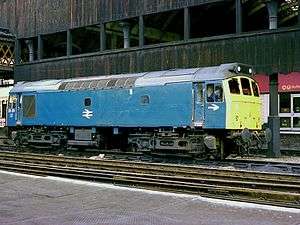 25211 in BR blue at Manchester Victoria in 1980. | |||||||||||||||||||||||||||||||||||||||||||
| |||||||||||||||||||||||||||||||||||||||||||
| |||||||||||||||||||||||||||||||||||||||||||
| |||||||||||||||||||||||||||||||||||||||||||
| |||||||||||||||||||||||||||||||||||||||||||
Background
The Class 24 locomotives were the precursor of the Class 25 design but after the delivery of their first few units it became apparent that the speed ceiling of 75 mph (121 km/h) was unduly restrictive and the provision of additional power would be advantageous. In the course of normal development the power output of the Sulzer six-cylinder engine had been increased by 90 hp (67 kW) to give a continuous traction output of 1,250 bhp (930 kW) at 750 rpm by the introduction of charge air cooling and the first locomotives to use this became known as Class 25 locomotives.
The Class 25 locos were primarily designed for freight work, but a significant number were fitted with boilers for heating passenger trains. Throughout the 1970s they could be found at work across the whole of the British Rail network although the Eastern and Southern Regions never had an allocation. Though regular performers into the early 1980s on Crewe–Cardiff passenger trains, they are best known in that respect for their use on the summer Saturday trains to Aberystwyth, a task they relinquished in 1984. The final Class 25 locomotive was withdrawn from service in March 1987.
Classification
| Code | Name | Quantity |
|---|---|---|
| BR | Bristol Bath Road | 6 |
| BS | Bescot | 34 |
| CF | Cardiff Canton | 12 |
| CW | Cricklewood | 14 |
| ED | Eastfield | 11 |
| EJ | Ebbw Junction | 12 |
| HA | Haymarket | 14 |
| KM | Kingmoor | 19 |
| LA | Laira | 11 |
| LO | Longsight Diesel | 30 |
| SP | Springs Branch | 49 |
| TI | Tinsley | 31 |
| TO | Toton | 51 |
| WN | Willesden | 31 |
| Withdrawn (1971–72) | 2 | |
| Total built: | 327 | |
Class 25/0
- Number sequence (original) D5151–D5175, (TOPS) 25 001–25 025
The first 25 locos became known as Class 25/0 and were built at the BR Darlington works using the newer 1,250 hp (930 kW) "B" engine, modified generator assembly and traction motors. This increase in power was obtained from an air/water free flow intercooler fitted between a higher capacity pressure charger and inlet manifold, included within the normal cooling circuit to maintain simplicity. The cylinder head was also modified and strengthened.
The BTH generator, type RTB 15656, was rated as 817.5 kW (1,096.3 hp), 750/545 V, 1090/1500 A at 750 rpm, only slightly different from that used in the earlier Class 24s. (Note all Class 25 locomotives used a generator designated as BTH RTB 15656 but its rating and characteristics changed over time). The generator supplied four BTH 137BX traction motors connected in parallel and rated 245 hp (183 kW), 545 V, 375 A at 560 rpm with a gear ratio of 18:79 (to give a 90 mph (140 km/h) maximum speed). Maximum tractive effort was 39,000 lbf (170 kN) and continuous tractive effort was 20,800 lbf (93,000 N) at 17.1 mph (27.5 km/h), the latter standard for all Class 25s. Power at rail was 949 hp (708 kW), now available between 9.3 and 77.6 mph (124.9 km/h). For the first fifteen locomotives fuel capacity was 520 imp gal (2,400 l; 620 US gal) (design type 25 AV) and the final ten had larger 620-imperial-gallon (2,800 l; 740 US gal) fuel tanks installed (design type 25 BV).
Class 25/1
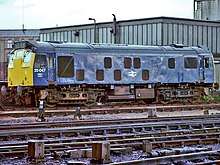
- Number sequence (original) D5176–D5232, (TOPS) 25 026–25 082
The Class 25/1 locomotives were built at BR Darlington and Derby locomotive works. They featured the new AEI 253AY traction motor, a result of the collaboration between BTH, MV and American builder Alco. This smaller, lighter motor was an attempt to market a traction motor to a worldwide audience, especially to the 1,000 mm (3 ft 3 3⁄8 in) metre gauge lines. For Class 25 locomotives these lighter motors meant the discontinuance of other weight saving measures being built into the design. They were highly rated in an attempt to overcome the loss of tractive effort normally found on starting. The field divert system was also modified to allow increased capability throughout all the speed ranges.
The main generator was a 12-pole machine with the rating changed to 819 kW (1,098 hp), 780/545V, 1050/1500A at 750 rpm. (The continuous rating has also been quoted as 819 kW (1,098 hp), 630V, 1300A). The four traction motors were now connected as series parallel pairs being rated at 234 hp (174 kW), 315V, 650A at 460 rpm, with a gear ratio 18:67. Pairs of motors connected in series provided a higher maximum tractive effort (usually quoted as 45,000 lbf (200 kN) although 47,000 lbf (210 kN) could be achieved) but the downside being that a series pair connected machine was more prone to slipping than one with an all parallel grouping. Full power was available between 7 and 77.5 mph (124.7 km/h), an improvement over Class 25/0 locomotives with all other ratings unchanged from the earlier series. The traction motor’s continuous rating of 650 amps was not far removed from its one-hour short term or 'emergency' rating of 680 amps, and this could only be monitored manually. On heavy trains close monitoring of the ammeters was necessary to avoid motor damage. Though the body shell remained similar to D5151 there were a number of refinements. The air horns were relocated to either side of the headcode panel. The cab skirt and body fairing were discontinued, though the support lugs remained. A new driving control panel was fitted. The fuel and water tanks were also redesigned with a fuel capacity of 510 imp gal (2,300 l; 610 US gal) (also quoted in sources as being 500 or 560 imp gal (2,300 or 2,500 l; 600 or 670 US gal)).
There were initially two variants of this sub-class. The vast majority were boilered and designated 251 AV. The four without train heating were designated 251 BV. In due course, when it was decided to fit dual braking to a number of locomotives, those previously 251 AV became 251 CX and one of the 251 BV (25032) became 251 DX.
Class 25/2
- Number sequence (original) D5233–D5299, D7500–D7597 (TOPS) 25 083–25 247
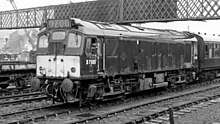
The Class 25/2 locomotives featured restyled bodywork and two-tone green livery similar to that carried by the Brush Type 4 (Class 47). The majority were built at BR Derby although some came out of the Darlington works. The redesign principally affected two areas, the cab and the location of the air intakes. The gangway doors fitted to the earlier examples were rarely used, their presence adding to the complaints of noise and draughts in the cabs and the removal of these allowed the centre windscreen to be enlarged, so that its lower edge lined up with the windscreens on either side giving a noticeably different front end look. The removal of the air filters from the side air louvers to the cantrail was the result of a comparison carried out at Inverness between a batch of Derby built Type 2s and a batch of BRCW Type 2s (Class 26 and Class 27), the tests targeting the air quality within the engine room. These tests revealed the location of the grilles on the Derby build allowed for much more debris to reach the filters (especially the lower ones), clogging them quicker, leading to poorer air quality within the engine compartment, and so potentially affecting performance and engine wear. With such a large order to be completed it was felt that a redesign of these areas would have a cost savings in the long run, in addition to a better working environment within the cabs, and with a general less cluttered look about the locomotive's exterior.
There were six variants of this sub-class, reflecting that locos were boilered and/or vacuum braked and/or dual braked. Boiler fitted locomotives included the first five (252 AV) and final thirty Class 25/2 (252 DV). Only members of the latter batch were modified for dual brake operation becoming 252 CX with the exception of 25242 that had had its boiler removed and was designated 252 FX. The non-boilered vacuum braked locos were 252 BV and when dual braked became 252 EX.
Class 25/3
- Number sequence (original) D7598–D7677 (TOPS) 25 248–25 327
.jpg)
The final batch of locomotives were designated Class 25/3 and was to be built by BR's Derby Works and Beyer, Peacock and Company of Manchester. However, because of financial problems Beyer, Peacock was unable to complete the final 18 locomotives and these were transferred to BR Derby for construction.
Though these locomotives still carried a RTB 15656 generator, this variant was a ten pole machine with a modified assembly incompatible with earlier equipment. The regulated (full hp) part of its characteristic was substantially the same as before but the unloading point, that is the point at which full power could no longer be utilised, was altered to 900 A, 910 V (819 kW) from 1,050 A, 780 V (819 kW). Only two stages of field weakening were employed, previous machines had six, and this provided ‘full power’ at speeds between 7 and 80 mph (130 km/h), and maximum tractive effort was reduced to 41,500 lbf (185,000 N).
The latter half of the 1960s had seen the widespread introduction of solid state electronics and these locomotives incorporated a control system where speed was detected electronically rather than mechanically. A signal from a tachogenerator was used to close contactors in sequence at given speeds to activate the motor's field weakening process, rather than through contacts and relays as in earlier types. The control system ensured the traction motors and main generator were all operated within the continuous rating of the machines except in full field conditions when the driver was able to judge how long to remain in the short-term rating condition. There were two variants of the Class 25/3 sub-class. Early 25/3 AV locomotives were fitted with vacuum brakes and in due course many of these were dual braked and redesignated 25/3 BX. By the time the last few locomotives were under construction dual braking had become the norm and ten of the last batch from Derby were built new as 25/3 BX locomotives for work out of Willesden on the recently upgraded West Coast Main Line.
Class 25/9
At the end of 1985 twelve of the remaining Class 25/3 locomotives were designated as 25/9, the intention being that they would operate on traffic won for the Industrial Minerals Division of Railfreight that included salt for road gritting from the ICI mine at Winsford. The locos were selected from the available pool of Class 25 locomotives in March 1985 with the expectation of three more years of service before 10,000 running hours since last Works attention would be reached and their maintenance would be concentrated at Carlisle Kingmoor TMD. At that point the expected cascade of motive power on BR as a whole would see them replaced by Class 31 locomotives. However, the traffic they were designated for was not captured and in due course the sub-class were withdrawn along with the other members.
Train Heating Units
Three Class 25/3 locomotives were converted in 1983 for use as mobile generators to provide electric heating on trains where the hauling locomotive could not supply this. They were given departmental numbers 97250 / 97251 / 97252 (formally 25310 / 25305 / 25314). They were referred to as ETHEL units (Electric Train Heating Ex-Locomotives), and unofficially named Ethel 1, Ethel 2 and Ethel 3. They were painted in a blue/grey livery in an effort to match the coaching stock livery of the day, but this was not too successful. Ethel 1 was withdrawn in 1987, the other two in 1990. All three were scrapped in 1994.
Prototype
In 1962 Sulzer designed and began development of a prototype diesel engine for higher outputs based on the LDA range. Rated initially at 1,700 hp (1,300 kW) at 850 rpm (with a development potential to 2,000 bhp (1,500 kW) at 850 rpm) it was approximately the same overall size as the 6LDA28 and designated LDA28-R. BR was approached with the idea that one of the Derby Type 2s should be fitted with this engine but development work proceeded slowly and problems with the 12LDA28-C (used on the Class 47 locomotive) diverted resources. In the end development was terminated and the locomotive set aside for its use, D5299, was completed as a standard Class 25/2.
Operation
The Class 25 locomotives were initially delivered to London Midland and Scottish regions while the Western Region had Class 22s to operate in the type 2 power classification. With the withdrawal of all diesel-hydraulic locomotives planned, there was a perceived gap in this power range, and locomotive 7657 worked trial trips between Exeter and Barnstaple in August 1971 resulting in the WR Chief Civil Engineer approving the use of the class as a direct replacement in the West of England.[3]
Preservation
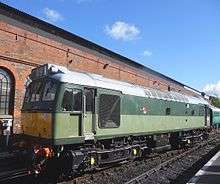
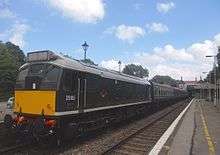
Twenty Class 25s have survived in preservation,[4] of all sub-types except Class 25/0.
| Numbers carried (Current in bold) |
Name | Location | Current Status | Livery | |
|---|---|---|---|---|---|
| D5185 | 25035 | Castell Dinas Brân | Great Central Railway | Operational | BR Green (Yellow Warning Panels) |
| D5207 | 25057 | - | North Norfolk Railway | Stored | BR Blue |
| D5209 | 25059 | - | Keighley and Worth Valley Railway | Operational | BR Blue |
| D5217 | 25067 | - | Nemesis Rail | undergoing restoration | BR Green (Yellow Warning Panels) |
| D5222 | 25072 | - | Caledonian Railway | Stored | BR Green (Full Yellow Ends) |
| D5233 | 25083 | - | Caledonian Railway | Stored | BR Blue |
| D7523 | 25173 | John F Kennedy | Battlefield Line Railway | Undergoing Repairs | BR Two-Tone Green (Yellow Warning Panels) |
| D7535 | 25185 | South Devon Railway | Operational | BR Blue (Full Yellow Ends) | |
| D7541 | 25191 | South Devon Railway | Undergoing Overhaul | BR Green (Yellow Warning Panels) | |
| D7585 | 25235 | - | Bo'ness and Kinneil Railway | Undergoing Overhaul | BR Blue |
| D7594 | 25244 | - | Kent and East Sussex Railway | Stored | N/A |
| D7612 | 25262 | - | South Devon Railway | Operational | BR Two-Tone Green (Yellow Warning Panels) |
| D7615 | 25265 | Harlech Castle | Burton-On-Trent, Nemesis Depot | Stored | BR Blue |
| D7628 | 25278 | Sybilla | North Yorkshire Moors Railway | Operational | BR Two-Tone Green (Yellow Warning Panels) |
| D7629 | 25279 | - | East Lancashire Railway | Operational | BR Two-Tone Green (Yellow Warning Panels) |
| D7633 | 25283 | - | Dean Forest Railway | Stored | BR Two-Tone Green (Yellow Warning Panels) |
| D7659 | 25309 | - | Peak Rail | Undergoing Repairs | BR Two-Tone Green (Yellow Warning Panels) |
| D7663 | 25313 | - | Wensleydale Railway | Stored | BR Blue |
| D7671 | 25321 | - | Midland Railway - Butterley | Stored | BR Green |
| D7672 | 25322 | Tamworth Castle | Churnet Valley Railway | Awaiting Restoration | BR Blue Variant |
The class returned to the main line in October 2007 when D7628 (25278) worked from the North Yorkshire Moors Railway to and from Whitby station.[5]
Nicknames
Railfans nicknamed the class Rats, as it was alleged they could be seen everywhere in Britain, and hence were "as common as rats". They were also known, mostly by their drivers, as Spluts, owing to their habit of spluttering when they broke down, which they often did.[6]
Model railways
In 1977 Hornby Railways launched its first version of the BR Class 25 in OO gauge.[7]
References
- http://www.brdatabase.info/locoqry.php?action=class&type=D&id=23
- British Railways Locoshed Book 1974 edition. Shepperton: Ian Allan. 1974. pp. 18–21. ISBN 0-7110-0558-3.CS1 maint: ref=harv (link)
- "Motive power miscellany". Railway World. Vol. 32 no. 378. Shepperton: Ian Allan. November 1971. p. 508.
- List of Class 25s Archived 15 May 2006 at the Wayback Machine Preserved Diesels.co.uk, Retrieved on 2008-04-08.
- October 2007 visit to Whitby Class25.info, Retrieved on 2008-04-08.
- Morrison, Brian (ed.). Modern Railways Pictorial, Annual 1986. Ian Allan. p. 110. ISBN 0-7110-1510-4.
- "Hornby BR Class 25 (Type 2)". Hornby Railways Collector Guide. Retrieved 1 February 2020.
Literature
- AEI/Sulzer (1962). Operating Manual for BR Type 2 Diesel Electric Locomotive Numbers D5000 – D5150 (1160 hp) and D5151 – D5175 (1250 hp). AEI/Sulzer Ltd.
- AEI/Sulzer (1966). Operating Manual for BR Type 2 Diesel Electric Locomotive Numbers D5176 – D5299 and D7500 – D7677. AEI/Sulzer Ltd.
- Marsden, C.J (1985). Brush-Sulzer Locomotives. Ian Allan.
- Marsden, Colin J. (1981). Motive power recognition:1 Locomotives. Shepperton: Ian Allan Ltd. ISBN 0-7110-1109-5.
- Tayler, A.T.H (1984). BR Locomotives:2 Sulzer Types 2 and 3. Ian Allan. ISBN 0-7110-1340-3.
- Webb, Brian (1978). Sulzer Diesel Locomotives of British Rail. David & Charles. ISBN 0715375148.CS1 maint: ref=harv (link)
- Rail Express Magazine, Issues 1 and 2, June/July 1996
- Ian Allan ABC of British Railways Locomotives, summer 1966 edition
Further reading
- Clarke, David (2006). Diesels in Depth: Classes 24/25. Ian Allan. ISBN 9780711031715. OCLC 71164327.
- Dady, Hugh (1989). Rail Portfolios 8: The 24s and 25s. Ian Allan. ISBN 9780711018464. OCLC 59998032.
- Marsden, C.J. (1981). Profile of the Class 24s and 25s. OPC. ISBN 9780860931355. OCLC 9283163.
- McManus, Michael. Ultimate Allocations, British Railways Locomotives 1948 - 1968. Wirral. Michael McManus.
- Nicolle, Barry J. (1985). The Last Years of the Class 25s. Ian Allan. ISBN 9780711014923. OCLC 59997232.
- Young, David (June 1996). "Class 25/9s: The untold story". Rail Express. No. 1. Foursight Publications Ltd. pp. 30–33. ISSN 1362-234X. OCLC 498432844.
- Kerr, Fred (June 1983). "The gutsy little 25s". Rail Enthusiast. EMAP National Publications. pp. 38–45. ISSN 0262-561X. OCLC 49957965.
- Rapson, David (June 1986). "The Class 25/9 story". Rail Enthusiast. No. 57. EMAP National Publications. pp. 6–8. ISSN 0262-561X. OCLC 49957965.
External links
| Wikimedia Commons has media related to British Rail Class 25. |
- Caledonian Railway Diesel Group.
- DerbySulzers.com: BR/Sulzer Type 2 locomotives
- Class25.info: Class 25 locomotives In Action
- D7629.com: Class 25 Detailed information, History, Operation
- : South Devon Railway Locomotive List
